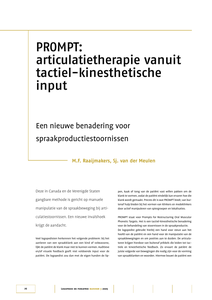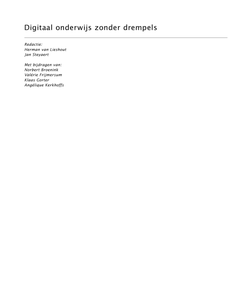We bevinden ons in een tijdperk waarin veel kinderen te dik zijn en te weinig bewegen. Daar wordt op verschillende manieren aandacht aan besteed, waarbij vooral wordt ingezet op het bevorderen van een gezonde actieve leefstijl. In dit artikel wordt ingegaan op de relatie tussen de motorische ontwikkeling van kinderen en een actieve leefstijl op latere leeftijd.
DOCUMENT

Objectives: The development of children’s motor competence (MC) from early to middle childhood can follow different courses. The purpose of this longitudinal study was to describe and quantify the prevalence of patterns of MC development from early to middle childhood and to identify undesirable patterns. Design: The study used a longitudinal design. Data were collected in three consecutive years, between February 2020 (T0) and May 2022 (T2). Methods: A total of 1128 typically developing Dutch children (50.2% male) between 4 and 6 years old at baseline (M = 5.35 ± 0.69 years) participated in this study. MC was measured with the Athletic Skills Track and converted into Motor Quotient (MQ) scores. To convert all individual MQ scores into meaningful patterns of MC development, changes in MQ categories were analyzed between the different timepoints. Results: A total of 11 different developmental patterns were found. When grouping the different patterns, five undesirable patterns were found with 18.2% of the children, showing an undesirable pattern of MC development between T0 and T2. The patterns of motor development of the other children showed a normal or fluctuating course. Conclusions: There is a lot of variation in MC in early and middle childhood. A substantial percentage of young children showed undesirable MC developmental patterns emphasizing the need for early and targeted interventions.
DOCUMENT

De prioriteit t.a.v. werkelijkheid verandert van extern naar intern
DOCUMENT
PROMPT is a tactile-kinesthetic approach for assessment and treatment of speech production disorders. PROMPT uses tactile-kinethetic cues to facilitate motor speech behaviors. Therapy is structured from basic motor speech patterns with much tactile-lkinesthetic cueing, towards complex motor speech activities with less cueing. This article describes the purpose and contents of PROMPT assessment and therapy.
DOCUMENT

Onderzoek van het Verwey-Jonker Instituut uit 2001 laat zien dat zo'n 10 procent van de totale studentenpopulatie in het Nederlandse hoger onderwijs belemmeringen ondervindt op grond van iin of meer functionele beperkingen. De voortgaande digitalisering van leeromgevingen in het hoger onderwijs kan kansen bieden om een verschuiving van drempels te bewerkstelligen. Maar er lijkt een tegenstelling te bestaan tussen het insluitend en uitsluitend potentieel van digitaal hoger onderwijs, een toegankelijkheidsparadox. Voor sommige functionele beperkingen is er sprake van verhoogde toegankelijkheid, voor andere evenwel van een verslechterde situatie. Voor een belangrijk deel hebben we de toegankelijkheid van digitaal onderwijs zelf in handen. Er kunnen hierbij tal van technologische hulpmiddelen gebruikt worden, voor uiteenlopende vormen van beperking (visuele, auditieve, motorische, cognitieve en spraak-/taalbeperkingen). Ook bevatten elektronische leeromgevingen en andere softwareproducten veelal specifieke functionaliteiten om de toegankelijkheid van digitaal onderwijs te vergroten. Er worden in deze publicatie zogeheten 'steekkaarten' aangeboden voor een aantal van deze applicaties: korte en bondige beschrijvingen van hun toegankelijkheidskenmerken. Maar gebruikers van deze software hebben vaak niet of nauwelijks profijt van de beschikbare mogelijkheden, zodat een grote groep studenten onvoldoende toegang krijgt. Dit heeft ondermeer te maken met de onbekendheid van het thema toegankelijkheid van digitaal onderwijs en de mythologie daaromheen (toegankelijke websites zouden bijvoorbeeld saai zijn en geen lay-out kunnen bevatten). Er is een verhoogd bewustzijn in het Nederlandse hoger onderwijs nodig over het thema toegankelijkheid, met een continue samenwerkingsactie van organisaties die structureel werken rond studenten met functionele beperkingen en/of rond elektronische leeromgevingen.
DOCUMENT

In deze rede zal ik vanuit het heden via de theorie en de wijze waarop theorie en praktijk verbonden zijn, een sprong maken naar de toekomst. Eerst zal ik een korte uiteenzetting geven over de positie van Nederland op het gebied van innovatie en ondernemerschap. Daarna zal ik een schets geven van het theoretische kader en de paradigma´s die naar mijn mening denken en doen in relatie tot innovatie en ondernemerschap bepalen. Tot slot wil ik een brug slaan naar de toekomst en de rol die het lectoraat Ondernemen en Innoveren (O&I) zal spelen om vernieuwing tot stand te brengen en het concept ondernemend innoveren vorm te geven.
MULTIFILE

Background: Poor motor skill competence may influence energy balance with childhood overweight as a result. Our aim was to investigate whether the age of motor milestone achievement has changed over the past decades and whether this change may contribute to the increasing trend observed in childhood overweight. Methods: Motor skill competence was assessed in children from the Young Netherlands Twin Register born between 1987 and 2007. Follow-up ranged from 4 up to 10 years. Weight and height were assessed at birth, 6 months, 14 months, and 2, 4, 7, and 10 years. Results: Babies born in later cohorts achieved their motor milestones ‘crawling’, ‘standing’, and ‘walkingunassisted’ later compared to babies born in earlier cohorts (N = 18,514, p <0.001). The prevalence of overweight at age 10 was higher in later cohorts (p = 0.033). The increase in overweight at age 10 was not explained by achieving motor milestones at a later age and this persisted after adjusting for gestational age, sex, and socioeconomic status. Conclusion: Comparing children born in 1987 to those born in 2007, we conclude that children nowadays achieve their motor milestones at a later age. This does not however, explain the increasing trend in childhood overweight.
DOCUMENT

Background: The aim of this study is to investigate whether age of infant motor milestone achievement is related to levels of physical activity (PA), weight status and blood pressure at age 4–7years of age. Methods: In the Dutch GECKO (Groningen Expert Center of Kids with Obesity) Drenthe cohort, the age of achieving the motor milestone ‘walking without support’ was reported by parents. Weight status and blood pressure were assessed by trained health nurses and PA was measured using the Actigraph GT3X between age 4 and 7years. Results: Adjusted for children’s age, sex and the mother’s education level, infants who achieved walking without support at a later age, spent more time in sedentary behaviour during childhood and less time in moderate-tovigorous PA. Later motor milestones achievement was not related to higher BMI Z-score, waist circumference Zscore, diastolic or systolic blood pressure. Conclusion: The results of this study indicate that a later age of achieving motor milestone within the normal range have a weak relation to lower PA levels at later age. It is not likely that this will have consequences for weight status or blood pressure at 4–7years of age.
DOCUMENT

Het doel van deze richtlijn is om hulpverleners handvatten te geven om jongeren met agressief gedrag effectiever te begeleiden. Het doel is dat patiënten meer inzicht krijgen in, en controle krijgen over hun agressieve gedrag. Dat draagt bij aan een gezonde psychosociale ontwikkeling van de jongere, aan een veiliger behandelklimaat binnen de behandelsetting en een prettiger werkklimaat voor hulpverleners Deel 1: Theoretische onderbouwing en aanbevelingen, die van belang zijn om goed met het interventiepakket te kunnen werken.
DOCUMENT

The main aim of this study was to determine the agreement in classification between the modified KörperKoordinations Test für Kinder (KTK3+) and the Athletic Skills Track (AST) for measuring fundamental movement skill levels (FMS) in 6- to 12-year old children. 3,107 Dutch children (of which 1,625 are girls) between 6 and 12 years of age (9.1 ± 1.8 years) were tested with the KTK3+ and the AST. The KTK3+ consists of three items from the KTK and the Faber hand-eye coordination test. Raw scores from each subtest were transformed into percentile scores based on all the data of each grade. The AST is an obstacle course consisting of 5 (grades 3 till 5, 6–9 years) or 7 (grades 6 till 8, 9–12 years) concatenated FMS that should be performed as quickly as possible. The outcome measure is the time needed to complete the track. A significant bivariate Pearson correlation coefficient of 0.51 was found between the percentile sum score of the KTK3+ and the time to complete the AST, indicating that both tests measure a similar construct to some extent. Based on their scores, children were classified into one of five categories: <5, 5–15, 16–85, 86–95 or >95%. Cross tabs revealed an agreement of 58.8% with a Kappa value of 0.15 between both tests. Less than 1% of the children were classified more than two categories higher or lower. The moderate correlation between the KTK3+ and the AST and the low classification agreement into five categories of FMS stress the importance to further investigate the test choice and the measurement properties (i.e., validity and reliability) of both tools. PE teachers needs to be aware of the context in which the test will be conducted, know which construct of motor competence they want to measure and know what the purpose of testing is (e.g., screening or monitoring). Based on these considerations, the most appropriate assessment tool can be chosen.
MULTIFILE
